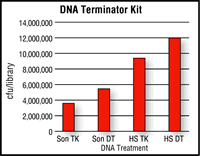*2019Гт РЬШФ УыБо ЧЯСі ОЪРН
DNATerminatorЂч End Repair Kit
- Repair sheared or restriction-digested DNA ends
- Increase cloning efficiency as much as a 500%
- Optimized system for consistent & reliable results
Repair DNA ends
Double-stranded DNA fragments for library construction or large-scale sequencing are often generated by mechanically shearing larger (genomic) DNA, a process that primarily leaves uneven ends. Large DNA may also be cut with restriction enzymes to generate smaller fragments for subcloning. Sheared or restricted DNA fragments must be ЁАend-repairedЁБ before ligation into blunt-end cloning vectors (e.g., LucigenЁЏs CloneSmartЂч, CopyRightЂч, or BigEasyЂч systems).
The DNATerminator End Repair Kit creates blunt, 5' phosphorylated ends on any type of sheared or restriction-digested DNA fragment, ensuring the highest possible cloning efficiency (Figure 1).
Figure 1. Effect of DNA shearing and end-repair methods on library construction efficiency. Shotgun libraries were constructed using 250 ng of lambda DNA sheared by sonication (Son) or by the GeneMachinesЂч HydroShearЂт device (HS). Sheared DNA was repaired with T4 DNA polymerase and Klenow fragment (TK) or DNATerminator End Repair Kit (DT) and cloned using LucigenЁЏs CloneSmartЂч system. Values are colony forming units (cfu) per library.
 IDT
IDT
